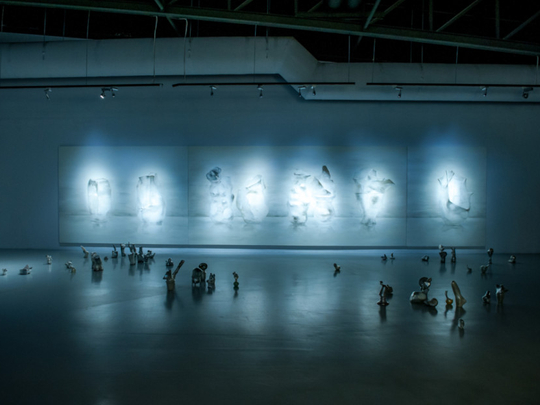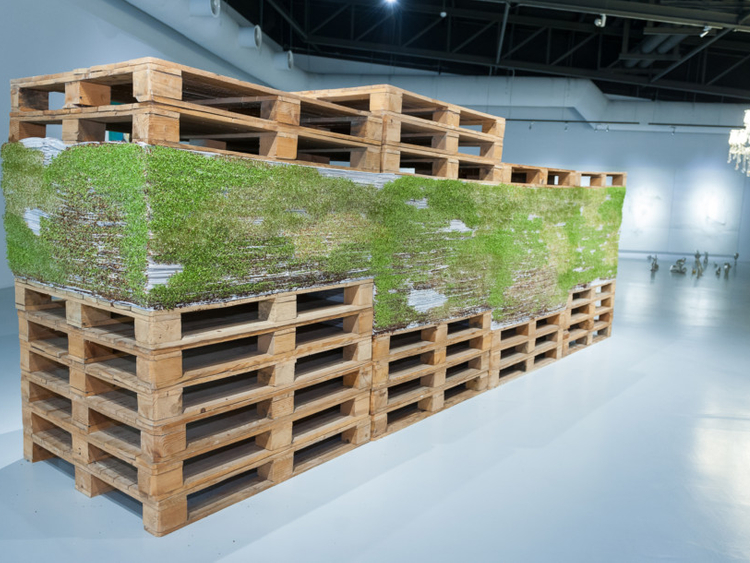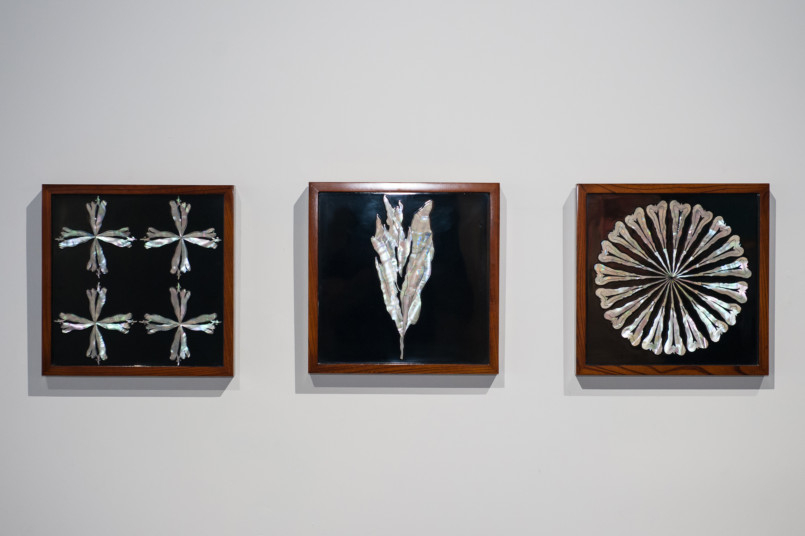
Curated by J.W. Stella, “[ana] please keep your eyes closed for a moment” is the first exhibition of Korean contemporary art presented by a public art institution in the MENA region.
The exhibition, spread over several floors of Maraya Art Centre in Sharjah, focuses on contemporary cultural practice in South Korea and across the Arab world. The background for this exhibition is that of cultural exchange through contemporary art practice between two very diverse cultures — Korean and Arab. It encourages a cross-cultural dialogue by bringing the works of 13 Korean artists to Sharjah, shown alongside the work of an Arab artist created from her experience of living in Seoul.
Fahrelnissa Zeid: Divine Protection by Yeesookyung. Oil on canvas, 2015
What the curator, who describes herself as a cultural nomad, has attempted is to focus on contemporary practice in South Korea and across the Arab world. Its premise is based on multi-sensory and intellectual interactions between the artists, curators, social anthropologists and audience.
Using the Arabic term “ana”, meaning “I or oneself”, Stella questions the notion of identity and the condition of the individual being.
The subtitle, “please keep your eyes closed for a moment”, is taken from the preamble to the novel “The Infinite Ethereal Breath” by Insung Lee. The author urges his readers to take action by closing their eyes briefly, with the intention of making them aware of their physical presence in their environment. The reader then becomes part of the story and this methodology allows the audience to play a role as active participants, rather than mere consumers of his novel. In this exhibition, Lee’s call to arms offers the spectator a seat at the table, alongside the artists and curator.
“Furthermore, the exhibition aims to bridge the gap created by unfamiliarity and media-driven prejudice, and bring about a closer understanding of these two different worlds. By inviting our audiences to the relational practice of contemporary art, the exhibition acts as a platform for congregating and learning about each other through a curious journey of the inevitable encounter,” Stella writes in the catalogue.
Collective sorrow
Speaking to Weekend Review, Stella says in the run-up to the preparation for the show, she as well as the artists were paralysed by the collective sorrow that enveloped her country when an overloaded ferry sank off South Korea’s southwest coast in April 2014, killing 304 people, mostly teenagers on a school trip. It took a long time for the artists to recover and one can sense the gloom and introspection in many of the works at the show.
Each of the participating artists was given a critical platform in an exhibition composed of multiple narratives that seeks to challenge the principles of a metanarrative or “greater value” system. This provided them with the opportunity to reflect upon the complexity of their own cultures and wider societies.
They were invited to draw on all kinds of elements that best reflect their lives in relation to their landscapes. Between South Korea and the Arab states, and Sharjah in particular, they responded with synaesthetic interpretations of their perspectives, rather than with fixed propositions.
Hong Soun works simultaneously in various mediums — installations, video, print as well as painting. The three-dimensional, tactile quality is ever-present in his work. In “Ordinary Moment” (triptych in oil on canvas and sculptures in mixed media) he is trying to resurrect forgotten memory.
The artist visited the coast near the spot where the ferry sank and found objects strewn about. He collected hundreds of them during subsequent visits to the spot. He wrapped them in clear tape over and over again to create small sculptures in memory of the victims. Those pieces, which embody the pain and chaos of the moment, also appear on his canvas. The resulting work is almost like a dialogue between the “lost souls” of the ferry disaster.
Flying across the Moonlight by Sujin Lee. Fishing basket, thread, wire, mixed media, 2015
“Memoryscape” and “Sidescape” are two of Hong Soun’s long-term projects that have been developed since early 2000. Having “memory” and “side” as his artistic motifs the artist turns to traditional art practices such as painting and sculpture. Hong Soun says he does not seek to represent the majoritarian view, preferring in his work to look at life from the margins.
Gayoung Jun, in her drawing, transforms mathematical concepts, geometrical patterns and colour gradation through her imagination in works such as “The Order of gayoung.drawing”, with the underlying message: “find me”.
Juyeon Kim, with her strong interest in nature, ecology and environment projects, uses live plants to convey her philosophical approach. In the time and site-specific installation “YI:SUK-X”, the artist grows thousands of seeds from various edible Korean plants on thousands of newspaper copies stacked on wooden crates. The living artwork sprouts and dies in the gallery space in the course of the exhibition, portraying “ana” and the vanity of life. “YI:SUK”, which was inaugurated in 2002, now makes its 10th appearance in Sharjah.
“I want to give more meaning to living beings,” says Kim. Her attempt is to bring universal impulses into her art practice that touches history, society and politics. The term “YI:SUK” connotes “every nature matures differently to the other”, a Buddhist concept.
Yesookyung, in her video work “Twin Dance” inspired by the Korean dance form Kyo-bang, explores the idea of tradition and the interplay between the self and the other in a rapidly changing economy. “I don’t like to artificially preserve the past. If it is really beautiful, it will survive,” she says.
In “Fahrelnissa Zeid: Divine Protection” (oil on canvas), Yesookyung copies a 1981 classic from Zeid, one of the pioneers of modern painting. “The image was very attractive to me. It was her spirit as well as technique that I focused on, while imagining myself in her shoes in another culture in order to learn.”
Zeid had said: “The first thing you have to do in order to achieve a masterpiece is to settle yourself in the picture with all your existence.” Yesookyung attempts to do this and becomes Zeid.
Yesookyung’s work is part of the “My Asian Modern Masters” series, an art practice based on extensive research on the artists in Asia who experienced their own form of Modernism in their own time. “By mimicking their unique painting techniques and authentic sense of aesthetics, Yeesookyung aims to pursue the indirect experiences of the diversity of Asian Modernism,” says Stella.
Collaboration is a crucial part of Young In Hong’s artistic process and practices based on performances, site-specific installations, embroideries, paintings and drawings. She explores the gap between public space and gallery space, and multiple identities of both public space and individuals.
In “Parallel Voices”, she collaborated with Dubai-based Steffi Bow to create graffiti across three walls, each with a story of its own. The two artists, working from two distant locations, collaborated on Skype. Bow says her artistic impulses could not be confined to a gallery, with the work of art symbolically trying to go outside of the limited space — an outcome of parallel identities.
Young In Hong’s method is summed up by her notes for a similar work she did in collaboration with Jonas Pike at Cecilia Hillström Gallery, Stockholm, two years earlier: “I propose a situation where two artists are equally independent in the process of making their works. One is mimicking graffiti through embroidery, and the other is in a sense breaking the autonomy of art in the gallery space. Neither artist need to entirely agree with each other’s aesthetic choices but are still working in parallel to each other.
“The conventions of art will be re-named and re-situated. By paralleling two different practices in one space, I would like to produce a ‘third space’ that blurs the boundaries between different sensibilities, spaces, realms of imagination and modes of authority, a space where the sense of command and authority is constantly shifting between two contrasting but parallel points of view.”
Earlier this year, Saudi Arabia-born Ghada Da, who works and lives in UAE, and emerging Korean artist Sujin Lee, who is based in Seoul, took part in the international artist residency exchange programme for two months, which was inaugurated as part of this exhibition, between Maraya Art Centre and Geumcheon Art Space in Seoul. Acting as the socio-cultural allegories of where they reside, these two young talents swapped their living environments with each other and explored the past and present of the cities.
Sujin Lee, who came to Sharjah on February 20, 2015, researched the traces of cultural exchange between Korea and the Arab world, and observed contemporary Sharjah. In this exhibition, Lee shows the mobile sculpture “Flying Across The Moonlight” (2015), which she produced during her residency. It is a poetic interpretation that combines Arabic astronomy, the story of labourers in the port of Sharjah and aspects of the artist herself.
When in Seoul, one of the fastest changing cities in the world, Da’s attention was drawn to Korean traditional craft, wooden lacquerware with mother-of-pearl, which she discovered at Insadong, one of the traditional art districts in the city.
Although there are differences in the patterns, mother-of-pearl also features among the most important traditional crafts in the Arab world. Her new production, “Orient” (2015), which explores the spirit and the body, was produced in collaboration with Korean master craftsperson Son DaeHyun, who specialises in mother-of-pearl craft.
Academic and social anthropologist Btihaj Ajana says, “Over all, what the collection of artworks in this exhibition attempts to do is to at once lay bare some of the actual forces and conditions that affect one’s reality and perceptions of self, while offering lines of flight for re-imagining new horizons and possibilities for ‘ana’, an ‘ana’ that has the potential to be unfettered by official identity ascriptions and a subjectivity that can be unburdened by the need to comply with the grand-narratives of nation and culture.
“If anything, this is an implicit invitation to reaffirm the importance of ‘ana’, especially at a time when individual differences no longer make any difference and personal space is shrinking into nothingness amid the homogenising force of an increasing neoliberal organisation of life and the living.”
Secret cinema
The exhibition actively engages with wider audiences through its Secret Cinema programme — a film screening section comprising eight short art films or video works — which will be shown at Maraya’s new screening room and will also travel to Abu Dhabi Art, A4 in Alserkal Avenue, Dubai, and Shanghai Duolun Museum of Modern Art in China.
The selected short films allow us a glimpse into the diverse lives of individuals and encourage us to emotionally connect with the protagonists in the stories.
The films, shown for the first time in the region, are directed by Ayoung Kim, Sojung Jun, Hyun Mi Yoo and the artist collective Red Carpet Spirit, led by Ingeun Kim.
The curator
J.W. Stella is the founding director of JW STELLA Arts Collectives, a London-based non-profit curatorial research lab. She also works as the International Associate Curator with Shanghai Duolun Museum of Modern Art, the first public contemporary art museum in China.
Her curatorial focus is socio-cultural anthropology that examines cultural relativism through contemporary art practices, and also questions the role of art and what it means to be making contemporary art in current societies.
N.P. Krishna Kumar is a freelance writer based in Dubai.
“[ana] please keep your eyes closed for a moment” will run at the Maraya Art Centre in Sharjah until January 2, 2016.














